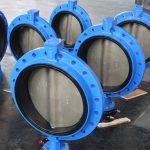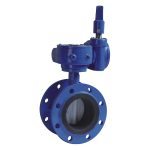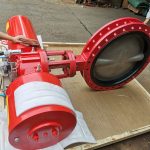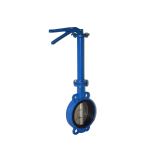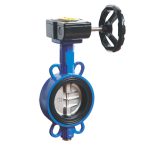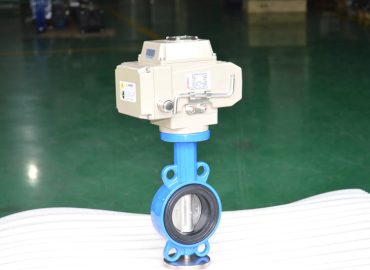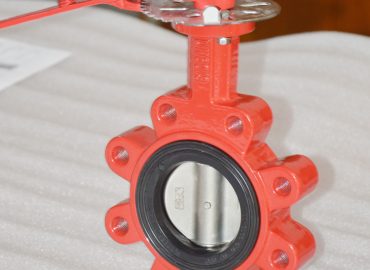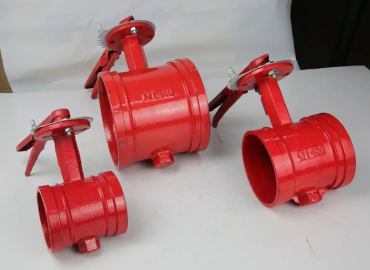Butterfly valve and gate valves are common types of industrial valves used in controlling and regulating the flow of fluids in various industries. Both valve types perform the same function of controlling the flow of fluids but have distinct differences in design, operation, and cost. Choosing the right valve type depends on various factors such as the type of fluid being contained, application, operating conditions, and cost factors. This post discusses the key differences between butterfly valves and gate valves, their advantages, disadvantages, and applications to help you choose the best valve for your specific needs.
Introduction
Butterfly valves and gate valves are commonly used in industrial applications to regulate fluid flow. While both valves control fluid flow, their design and operation differ significantly. The gate valve consists of a movable gate that opens and closes to regulate fluid flow. They operate in either a fully open or fully closed position, making them suitable for applications where flow needs to be shut off completely. Butterfly valves, on the other hand, operate by a disc moving in a direction perpendicular to the direction of fluid flow. This design makes them suitable for applications where flow regulation is required such as in wastewater treatment plants. These differences in design, application, and operation provide advantages and disadvantages unique to each valve type, making selection crucial to maintaining efficient and safe operational environments.
Explanation of what butterfly valve and gate valve are
Butterfly valves and gate valves are both industrial valves used to regulate the flow of fluids in pipes or pipelines. A wafer butterfly valve is a quarter-turn valve that operates by rotating a disc or vane in the flow path, which allows or restricts the flow of fluid when in open or closed position. The butterfly valve is lightweight, compact, and requires less maintenance, making them useful in applications that require frequent valve operation. On the other hand, a gate valve is a linear motion valve that operates by moving a gate up and down to allow or restrict the flow of fluids. They are most suitable for applications that require on/off control of fluid flow, such as isolation or shut-off valves. Gate valves are more massive and require more maintenance, but they offer better sealing and pressure capabilities compared to a butterfly valve.
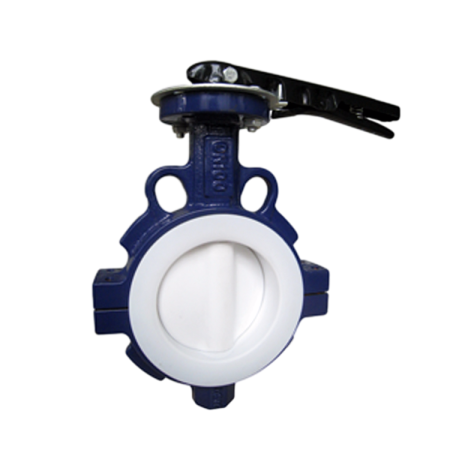
Importance of choosing the right valve for your application
Choosing the right valve for an application is crucial for system efficiency, safety, and durability. Failing to select the right valve type can result in system malfunctions, leaks, or even catastrophic failure, causing injuries, downtime, and costly repairs. Choosing the right valve requires knowledge of the fluid type, flow rate, pressure, temperature, and application. The wrong valve can damage the system or compromise the quality of the fluid or gas, directly affecting production efficiency or product quality. Thus, choosing the right valve provides benefits such as better system efficiency, reduced energy consumption, reduced maintenance needs, and a safer workplace environment. When selecting a valve, the user must consider factors such as cost, maintenance, and environmental impact while prioritizing the valve’s intended function to ensure optimal performance and system longevity.
Butterfly Valves
Butterfly valves are quarter-turn valves that regulate fluid flow using a disc or vane in the flow path. These valves are commonly used in industrial applications where flow regulation is required. They are known for their compact size, lightweight, and low maintenance needs, making them a popular choice for many applications. Butterfly valves are also cost-effective and easy to install while featuring fast open and close times, which is crucial in emergency situations. These valves can handle a wide range of pressures and temperatures, making them versatile enough to use in various systems. Their versatility is also improved through the body and disc material options, which can be customized to match specific system requirements. Butterfly valves find use in industries such as chemical processing, water and wastewater management, mining, and other applications where flow control is needed.
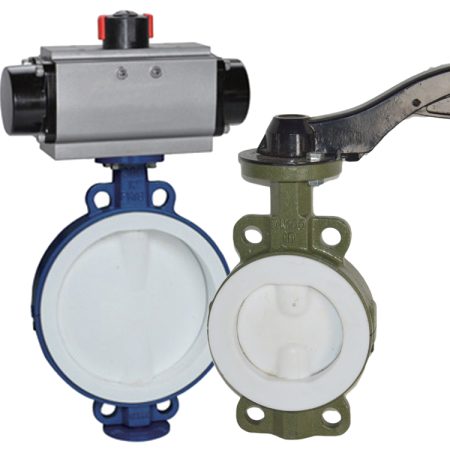
Overview of butterfly valves
Butterfly valves are a type of industrial valve designed to regulate and control the flow of fluids through pipes or pipelines. They are named after their design, which generally consists of a round or oval-shaped disc that rotates around a shaft located in the center of the valve. The disc is mounted perpendicular to the direction of fluid flow and is used to slow or stop the flow of fluids through the valve. Butterfly valves have gained popularity due to their low size, lightweight, low maintenance required for operation, and fast opening and closing, making them ideal for emergency use. They are cost-effective and efficient, and they are available in a wide range of materials, sizes, and types, allowing them to be used in a variety of industrial applications, including oil and gas, water and wastewater treatment, mining, and more.
Operation mechanism
The operation mechanism of butterfly valves involves rotating the disc 90 degrees from its fully open position to its fully closed position to allow or restrict fluid flow. When fully open, the disc is perpendicular to the fluid flow, which results in minimal obstruction and high flow capacity. As the disc rotates, it begins to obstruct the fluid flow, creating a more restricted flow path, achieving a gradual shut off of fluid flow. Butterfly valves are actuated by manual levers, electric or pneumatic motors, or hydraulic cylinders. These actuation options make them adaptable to different types of plants and industries, providing efficiency in operation, accuracy in position control, and reduced maintenance requirements. Newer versions of the butterfly valve use electronic sensors to monitor and control the disc’s position, resulting in more precise, automated control of flow rates, pressure, and temperature.
Advantages of using a butterfly valve
Butterfly valves offer several advantages that make them a popular choice for many industrial applications. Firstly, they have a compact design and are lightweight, making them easy to handle and install. Secondly, butterfly valves require minimal maintenance compared to other types of valves, reducing operating and maintenance costs over time. Thirdly, they have a high flow capacity that minimizes pressure loss, making them efficient in preventing system leakage. Additionally, the fast opening and closing of butterfly valves make them ideal for emergency situations where a quick response is necessary, and lastly, butterfly valves offer versatility, as they can handle different temperatures, pressures, and fluids. These advantages make butterfly valves suitable for various applications, including food and beverage processing, water treatment, and cooling towers, among many others.
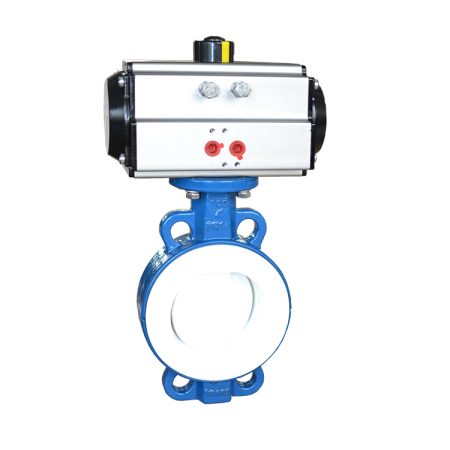
Disadvantages of using a butterfly valve
Despite their advantages, butterfly valves also have a few disadvantages that must be considered before selecting them for an application. Firstly, butterfly valves may not be suitable for applications that require highly precise flow control as they do not provide the same degree of accuracy as some other valve types. Secondly, they are not suitable for handling large solids or slurries as the disc may hinder free flow and cause clogging. Thirdly, the disc can be vulnerable to damage, which can lead to the valve leaking when not adequately protected from abrasives or other objects under high-pressure or flow conditions. Lastly, butterfly valves may not perform well in applications where the valve must handle high pressure, as they can be prone to leaks or ruptures under such conditions. Therefore, consideration of the application and system requirements is needed to select the right valve type that offers optimum performance and safety.
Gate Valves
Gate valve are among the oldest and most commonly used types of industrial valves. They are linear motion valves that operate by opening or closing a gate or wedge to regulate the flow of fluid through the valve. Gate valves can be fully opened and fully closed, making them ideal for applications where fluid flow needs to be completely shut off, such as in isolation or shut-off valves. They are robust and can handle high pressure, high-temperature fluids, making them suitable for use in applications where harsh operating conditions exist. Gate valves are available in various sizes, types, and materials, making them versatile for use in different industries, including oil and gas, water treatment, and power plants.
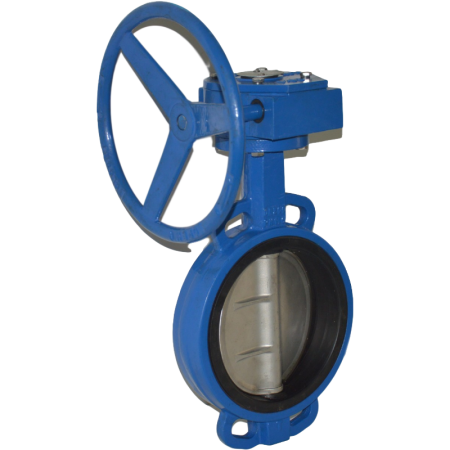
Overview of gate valves
Gate valves are industrial valves that are designed to control and regulate fluid flow by using a gate or wedge to cover or uncover a flow channel, located perpendicular to the direction of movement in a pipeline. Gate valves typically use a multi-turn handle or wheel to open and close them and are often used for fully open or fully closed applications. They feature a simple design, high durability, and high pressure resistance, making them ideal for the oil and gas, petrochemical, power generation, and water and wastewater treatment industries. They also come in a variety of materials, sizes, and types, including rising stem gate valves, non-rising stem gate valves, slab gate valves, and wedge gate valves, giving them versatile applications. While gate valves may require more maintenance than other valve types, they offer excellent sealing and long-lasting durability, making them a reliable choice for regulating fluid flow.
Operation mechanism
Gate valves operate by using a gate or wedge to control fluid flow. This gate is lowered into position to allow flow through the valve when the valve is open and raised into position to stop fluid flow when the valve is closed. The handle or wheel to operate the valve typically requires several turns to provide the necessary force to move the gate up or down. Gate valves are available in two main types: rising stem and non-rising stem valves. In rising stem gate valves, the stem that connects the handle or wheel to the gate rises and falls with the gate, allowing the user to visually check the position of the gate. In non-rising stem gate valves, the stem remains stationary while still moving the gate up or down, meaning the user cannot verify the position of the gate visually. The operation mechanism of gate valves makes them easy to use and reliable while providing a high degree of control over system fluids.
Advantages of using a gate valve
Gate valves offer several advantages that make them an excellent choice for a range of industrial applications. Firstly, they provide full open or full close function, so they are ideal for isolation or shut-off valves, providing high, reliable sealing performance. Secondly, they are compatible with a wide range of fluid types, temperatures, and pressures, making them versatile, efficient, and applicable to several industries, including oil and gas, water treatment, and mining. Thirdly, they are easy to operate and require minimal maintenance, ensuring low operation costs and reducing downtime for maintenance. Lastly, gate valves offer good flow control when they are open, allowing them to reduce energy consumption and minimize the risk of system cavitation. These benefits make gate valves the go-to valve technology for many industrial applications, where isolation, on/off flow control, and high-pressure capabilities are essential.
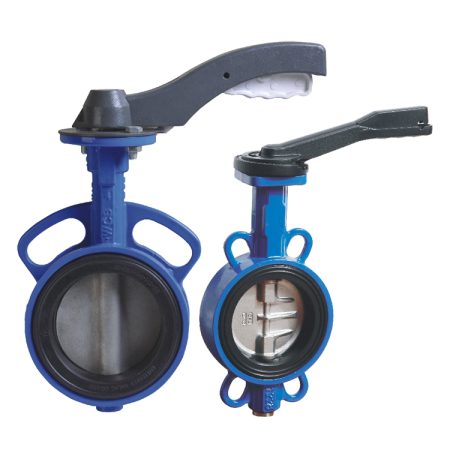
Disadvantages of using a gate valve
Despite their many advantages, gate valves have some disadvantages that should be considered when selecting the right valve type for an application. Firstly, gate valves require more space to operate compared to other valve types due to their design. They are not ideal for use in tight spaces. Secondly, gate valves can accumulate dirt and debris in the seat, which can cause leakage or prevent the gate valve from operating correctly. Thirdly, gate valves are slower to operate compared to other valve types, and the wheel or handle requires multiple turns to open and close fully. As such, they may not be suitable for emergency applications where quick responses and more precise flow control are required. Lastly, gate valves require maintenance due to the potential erosion of the gate disc and seat over time, which can reduce the valve’s performance and longevity. Therefore, it’s crucial to consider these factors when selecting the type of valve best suited to an application.
Comparison Between Butterfly Valve and Gate Valve
Butterfly valves and gate valves are both widely used for flow control in various industrial applications, but they differ in design, mechanism, and applications. Butterfly valves have a compact, lightweight design and provide fast and easy operation, making them ideal for applications requiring frequent use or emergency shut-off. They are usually cheaper than gate valves and suitable for low to medium pressure applications. On the other hand, gate valves offer better isolation, a tight seal, and are suitable for high-pressure applications, where fluid flow regulation is less frequent. They have a slower operating mechanism, require more space to operate but offer precise, on/off flow control, and are usually more expensive than butterfly valves. In summary, the selection between butterfly valves and gate valves should be conducted based on the specific system requirements, pressure, temperature, flow rate, and the frequency of the fluid flow regulation.
Differences in design and construction
The design and construction of butterfly valves and gate valves differ significantly. Butterfly valves consist of a disc or plate that rotates to regulate fluid flow through the valve. They are generally more compact and lighter than gate valves, making them well-suited for applications where weight and space are critical factors. Butterfly valves are usually made of materials such as cast iron, steel, or PVC, making them suitable for various applications. Gate valves, on the other hand, use a wedge or gate to control fluid flow through the valve. These valves are typically heavier than butterfly valves due to their larger size and are made of materials such as cast iron, stainless steel, or bronze. They are a good choice for applications that require high-pressure capability, and they allow for a tight seal when fully closed. The design and construction differences between butterfly valves and gate valves affect their performance, weight, cost, and the types of applications they are suitable for.
Differences in flow control
The flow control mechanisms of butterfly valves and gate valves also differ significantly. Butterfly valves regulate fluid flow by rotating a disc, perpendicular to the flow channel. When the disc is rotated parallel to the flow channel, it offers minimum obstruction to fluid flow, providing a high flow rate. On the other hand, gate valves use a gate or wedge to regulate fluid flow by raising or lowering the gate. When the gate is raised, the flow channel is open, allowing a high flow rate, while fully closing the gate prevents fluid flow altogether. While butterfly valves are ideal for applications that require fast, efficient flow control and emergency shut-off, gate valves provide slow, but precise, on/off flow control, making them well-suited for high-pressure applications that require more precise adjustments. Therefore, the selection of the appropriate valve type should be based on the specific flow channel requirements and the application.
Differences in operating mechanism
The operating mechanisms of butterfly valves and gate valves present notable differences. Butterfly valves are typically operated via a handle or lever that is turned either clockwise or counterclockwise to rotate the disc, which controls fluid flow. The handle requires a relatively small amount of force, and the disc can be turned multiple times to achieve the desired flow. In contrast, gate valves require a larger amount of force to operate, and the wheel or handle must typically be turned several times to raise or lower the gate. The force required to operate a gate valve can also increase significantly at higher pressures or if the valve is partially obstructed. However, gate valves tend to provide a tighter seal than butterfly valves, especially when closed, resulting in reduced leakage, while butterfly valves are ideal for applications requiring a quick response and fast emergency shut-off.
Differences in pressure and temperature limitations
The pressure and temperature limitations of butterfly valves and gate valves are also different. Butterfly valves are suitable for low-pressure applications, with most types operating between 150 and 300 psi. They are also capable of handling temperatures ranging from -40°F to 500°F, depending on the material used in construction. In contrast, gate valves can handle much higher pressures, typically ranging from 150 to 6,000 psi. They are also capable of handling a wide range of high temperatures based on the material used in construction, and are often used in highly demanding and critical applications where high pressure and temperature requirements are a concern. Ultimately, the correct valve selection should depend on the specific pressure and temperature requirements of the system in which they are required to operate.
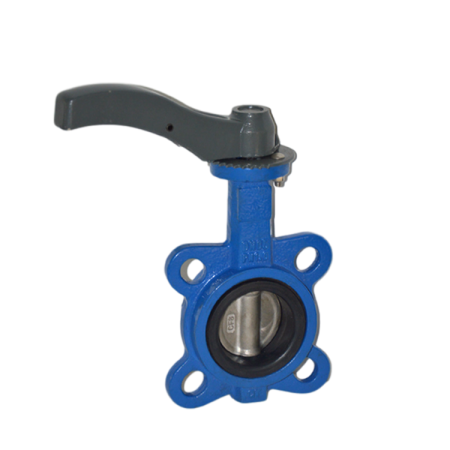
Conclusion
In conclusion, butterfly valves and gate valves are both essential components of fluid control systems used across various industries. The choice between the two largely depends on the specific system requirements such as pressure, temperature, flow rate, and the type of flow control needed. Butterfly valves offer a quick response time, easy operation, and are ideal for low-pressure systems, while gate valves offer slow, precise flow control, a tighter seal when closed, and are suitable for high-pressure applications with stricter flow control requirements.
The design, construction, and operating mechanisms of butterfly valves and gate valves present notable differences. Butterfly valves consist of lighter, more compact designs, making them easier to operate and more suitable for lower pressure systems. Alternatively, gate valves feature a heavier design for use in high-pressure applications with stricter flow control requirements.
When selecting the appropriate valve type for your system, it’s essential to consider the system’s specific requirements. This includes the pressure and temperature capabilities, flow rate, and how precise the flow control needs to be. Because of the differences in design and operation, the choice between the two valves is vast and offers a wide variety of applications.
In conclusion, both butterfly valves and gate valves have pros and cons. Ultimately, the correct valve should be based on your system requirements, budget, and the specific needs of the application. Working with a knowledgeable valve supplier or manufacturer can help ensure you choose the right valve for your needs so that you can achieve maximum efficiency and reliability from your fluid control system.
Summary of key points
To summarize, butterfly valves and gate valves are essential components of fluid control systems, but they differ significantly in design, construction, flow control, pressure and temperature limitations, and operating mechanism. Butterfly valves offer a compact, lightweight design, quick response times, and efficiency for low to medium pressure applications, while gate valves offer tight sealing, precise, on/off flow control, and high-pressure capabilities. The choice of the right valve type depends on the specific system requirements, pressure, temperature, flow rate, and the type of flow control needed. Choosing the right valve requires careful consideration of the advantages and disadvantages, working with a knowledgeable valve supplier, and ensuring that the valve meets the application needs. Ultimately, selecting the right valve is crucial for maximizing system efficiency and reliability.
Final thoughts on when to use a butterfly valve vs. gate valve
Choosing between a butterfly valve and a gate valve ultimately depends on the specific needs of your system. Butterfly valves are ideal for low-pressure applications that require a quick response time, such as in the food and beverage industry or HVAC systems. Gate valves are better suited for high-pressure applications that demand precise flow control, like in oil and gas production or power plants. It’s crucial to consider factors such as the pressure and temperature capabilities, flow rate, and flow control requirements when selecting the appropriate valve type. Ultimately, working with a knowledgeable valve supplier or manufacturer can help ensure you choose the right valve for your particular application. By taking the time to select the right valve, you can improve overall system efficiency, minimize downtime, and reduce overall costs associated with system maintenance and operation.


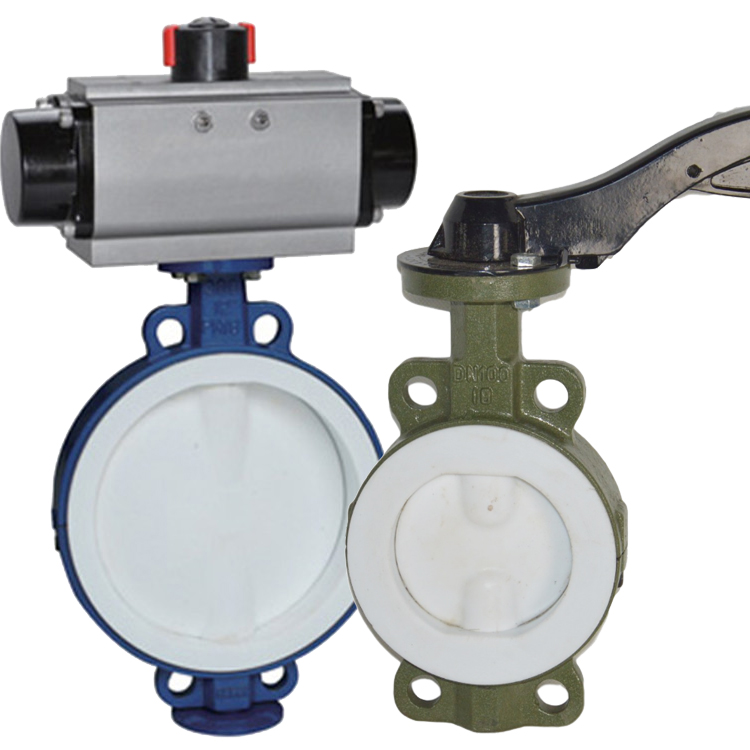
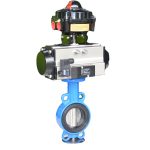
-150x150.jpg)
